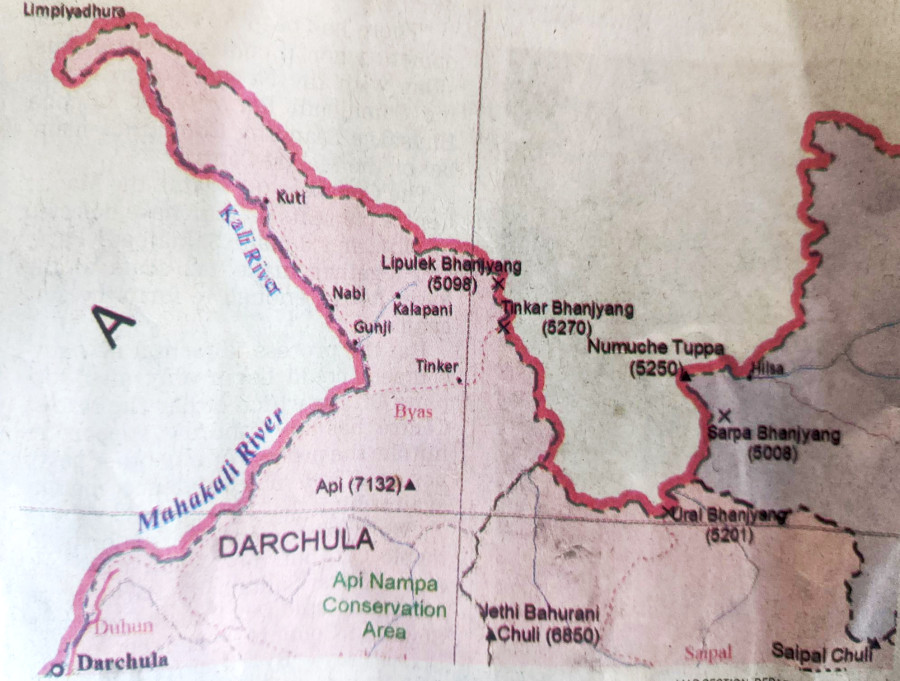National
Government plans to hold census in Kalapani but doesn’t know how
Sending enumerators there looks impossible, local leaders say. Authorities are mulling over counting residents on the basis of past Indian census data or satellite imagery.
Prithvi Man Shrestha
During the decennial census every household in the country is visited and a headcount of those living in the country taken.
That means in the 2021 census, which begins in June, authorities will also have to count the people living in the Kalapani area that has been incorporated as part of Nepal, as per a new constitutionally adopted map published last year.
But there is a catch.
India continues to maintain its claim over the Kalapani area in Darchula district on the northwestern edge of Nepal.
While officials of the Central Bureau of Statistics, the government authority responsible for conducting the census, are intent on covering that area, they are concerned if they could send enumerators there, as the move might invite bilateral tensions.
“Indian authorities have prohibited Nepalis from going to the Kalapani area for the last several decades,” said Dilip Budhathoki, chair of Byas Rural Municipality in which the Kalapani area falls.
Given the situation, Nepali authorities are mulling two options to conduct the census in the area.
Hem Raj Regmi, deputy director general of the Central Bureau of Statistics, said: “One option is using satellite imagery of the houses in the area and estimating the number of people based on that. Another option is estimating the current population based on India’s census report of 2011 and estimated growth rate of population in the area.”
Officials say the bureau has already collected the data on the population there based on India’s 2011 census, according to which, there are 363 people in Kuti, 78 in Nabi and 335 in Gunji, the three villages in the region.
“However, no final decision has been taken regarding using any of the options,” Regmi said.
Nepal had last conducted the census in Lipulekh six decades ago by sending enumerators door to door.
Chief district officers of Darchula dispatched reports to the Home Ministry about the activities in these villages until around 1990.
But after the Sino-India war of 1962, the area has been under Indian control as it is a strategic point on the Nepal-India-China trijunction.
A row between Nepal and India flared up in November 2019 when New Delhi published a new political map of India placing Kalapani, Lipulekh and Limpiyadhura within its territory.
Delhi cold-shouldered Kathmandu’s request for diplomatic dialogue to resolve the issue.
Then in May last year India built a link road via Lipulekh to Kailash Mansarovar in the Tibet Autonomous Region of China.
Taking umbrage at the Indian move, the KP Sharma Oli government published a new map incorporating the area as part of Nepal and in June last year endorsed the map through Parliament amending the constitution.
Nepal-India relations, which had hit a low, have shown signs of improvement lately but the two countries have yet to find an amicable solution to the row over the Kalapani region.
In the given context, politicians and officials say that it is virtually impossible to hold a census by sending enumerators to the area which is in complete administrative control of India, without India allowing Nepal to do so.
According to Budhathoki, chair of Byas Rural Municipality, even Indian nationals need to produce their identity cards and they are interrogated when they enter the area.
“Nepalis who have family relations with people in the Kalapani region are allowed to go occasionally and only during deaths or similar situations,” Budhathoki told the Post over phone from Byas.
In an article in the Post last June, Buddhi Narayan Shrestha, former director general of the Department of Survey, wrote that Nepal had conducted population census in Kuti, Nabi and Gunji informally in 1991, and had recorded the numbers of households and population.
According to Shrestha, during the 1991 census, 150 houses and a population of 723 had been recorded in the three villages.
Dilendra Prasad Badu, a Nepali Congress lawmaker from Darchula, said he does not think it is possible to conduct a census in the Kalapani area given the heavy restrictions on Nepalis to go there.
“Until we settle boundary disputes with India in the region, I don’t think there is any chance for us to conduct a census there,” Badu told the Post.
According to Badu, even if India agrees that the land belongs to Nepal, people residing in the area may need to be asked whether they want to become Nepali citizens.
A majority of the people living in the area depend completely on India and they say even reclaiming Kalapani by Nepal won’t make much of a difference until the Nepali state pays adequate attention to them.
Despite the government saying it will conduct a census in the disputed Kalapani area, it has not issued any specific instructions to the local administration of Darchula where the Kalapani area falls.
“We have not received any instructions from higher authorities regarding conducting census in the Kalapani area. We will act accordingly once we receive any instructions,” said Siddharaj Joshi, chief district officer of Darchula. “As we have no administrative presence in the Kalapani area, we cannot go there to conduct a census.”
Budhathoki, the chair of Byas Rural Municipality, is even more blunt.
“Given the conditions, conducting a census in the area is just a pipe dream,” Budhathoki told the Post.
The 2021 census will be conducted from June 8 to June 22.
The Central Bureau of Statistics has already appointed 39,000 enumerators and 8,000 supervisors to conduct the 2021 census across the nation.
Officials say they are prepared to carry out their work and when it comes to the Kalapani area, they need a concrete decision and clear instructions from the government. According to them, even though they have discussed the alternatives to going to the field [Kalapani area], the government has not yet taken any decision.
“Irrespective of modality, the government is in favour of conducting population census in the Kalapani area,” said Min Bahadur Shahi, a member of National Planning Commission under which the Central Bureau of Statistics works.




 16.2°C Kathmandu
16.2°C Kathmandu







%20(1).jpg&w=300&height=200)






